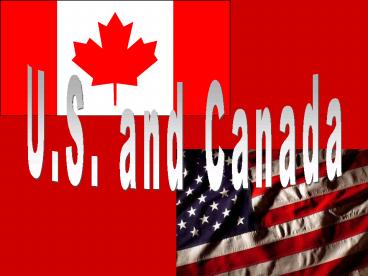Unit 2: U.S. and Canada PowerPoint PPT Presentation
1 / 22
Title: Unit 2: U.S. and Canada
1
U.S. and Canada
2
Physical Geographyof US and Canada
3
Major Landforms
- The Appalachian Mountains
- Mountain chain extending for 1,600 miles from
Newfoundland to Alabama - The Interior Lowlands
- Level land that covers interior of North America.
- Divided into the Interior Plains, Great Plains,
and Canadian Shield - The Western Mountains, Plateaus, and Basins
- Mountain range extending for 3,000 miles from
Alaska to New Mexico - The Islands
- Canadas northern most lands, Aleutian Islands
(coast of Alaska), and Hawaii
4
4 Regions of US and Canada
- The Eastern Lowlands
- The Appalachian Highlands
- The Interior Lowlands
- Western Mountains, Plateaus, and Basins
5
The Appalachian Mountains
- Highlands
- Approximately 1,600 miles long
- Made up of several mountain ranges
- Green, Catskill, Blue Ridge, and Great Smoky
- 300 million years old (eroded)
- Highest peak Mt. Mitchell (6,684 ft.) in North
Carolina - Deciduous trees that lose leaves in the fall.
6
Highest point in Appalachians Mt. Mitchell
(6,684 ft.)
7
The Interior Lowlands
- Divided into 3 sub regions
- Interior Plains Central low lying area of North
America - Great Plains produces about 25 of the worlds
wheat, oats, barley, rye, sorghum and corn in the
world - Canadian Shield - covers about 2 million square
miles around the Hudson Bay, lots of coniferous
trees
8
Great Slave Lake Located in Canadian Shield and
source of the Mackenzie River (deepest lake in
North America, second largest lake in Canada)
9
Western Mountains, Plateaus, and Basins
- Rockies
- Series of mountain ranges that extend _at_ 3,000
miles in length from Alaska to New Mexico - 80 million years old (relatively young)
- Peaks about 12,000 feet
high - Contains the Continental
Divide
Mt. Logan highest point in Canada (19,550 ft.)
10
The Continental Divide
- The divide runs along highest points of the
Rockies, from British Columbia, through the
United States, and continues southward into
Mexico and Central America. - It divides the rivers into those flowing eastward
and those flowing westward.
11
Mount McKinley (Alaska Range) N. Americas
tallest peak (20,320 ft)
The Cascade Range Extends from British Columbia
to Northern California
Mount St. Helens (Cascade Range) The deadliest
and most economically destructive volcanic
eruption in the history of the United States.
Crater Lake The deepest lake in the United
States. Caused by the collapse of a volcano
Sierra Nevada Range Extends from Northern to
Southern California
12
Mt. McKinley
- Highest peak in North America
- Located in Alaska
- 20,320 feet above sea level
13
Mt. Rainier
Mt. Whitney
Highest point in continental U.S. and Sierra
Nevada Mountains (14,494 ft.)
Highest point in Cascade Mountains (14,411 ft.)
14
Islands
- Hawaiian Islands
- politically part of the U.S., but geographically
different - Canadas northernmost islands islands riding the
icy seas near the Arctic circle - Aleutian Islands
- extend off of the southwest portion of Alaska
15
(No Transcript)
16
Canadian Islands
There are over 52,000 islands in Canada. Baffin
Island largest island (840,000 sq.
miles) Manitoulin Island - Worlds largest
island in a freshwater lake, (1,067 sq. miles)
in Lake Huron
17
Oceans and Waterways
- Great Lakes
- Huron, Ontario, Michigan, Erie, and Superior
- These lakes plus the St. Lawrence River form one
of the worlds major shipping routes - Mackenzie River
- Canadas longest river
- Mississippi-Missouri-Ohio
- North Americas longest and busiest river system
18
United States Rivers
Mississippi River 2nd longest river in North
America (2,350 miles), starting at Lake Itasca
in Minnesota Missouri River longest river in
North America (2,500 miles), starting in
mountains of Montana. Combination of Missouri
and Mississippi rivers forms the third largest
river system in the world (3,740 miles)
Rio Grande 3rd longest river in North America
(1,885 miles), starting in Colorado
Colorado River powerful river forming canyons
throughout time (1,450 miles) , starting in
Colorado
19
Great Lakes
Rivers of Canada/Alaska
- Mackenzie River Longest river in Canada (1,100
miles) - Yukon River 3rd longest river in North America
(1,979 miles) - St. Lawrence River 2nd greatest discharge rate
in North America, forms the St. Lawrence Seaway
(connecting the Great Lakes to the Atlantic Ocean)
20
Lakes of U.S. Canada
Lake Superior largest freshwater lake in the
world (31,820 sq. miles) Lake Huron 3rd
largest lake in the world (23,010 sq.
miles) Lake Michigan 4th largest lake in the
world (22,400 sq. miles) Great Bear Lake 8th
largest lake in the world (12,000 sq.
miles) Great Slave Lake 10th largest lake in
the world (11,170 sq. miles) Lake Erie 12th
largest lake in the world (9,930 sq. miles) Lake
Winnipeg 13th largest lake in the world (9,094
sq. miles) Lake Ontario 14th largest lake in
the world (7,520 sq. miles)
21
Just the Facts - Canada
- Canada is the 2nd largest country in the world
(3,851,809 sq. miles) - Canada has the worlds longest coastline (125,500
miles) - Oceans border Canada on three sides (Pacific to
west, Atlantic to east, Arctic to north) - Nearly ¼ of all fresh water in the world is in
Canada - Forests cover almost ½ of Canada
- Canada has 1/10 of the worlds forests
- Canada is the worlds fifth largest energy
producer - Canada ranks in the top five in the world
producers of - Natural gas
- Copper
- Zinc
- Nickel
- Aluminum
- Gold
22
Just the Facts United States
- The U.S. is the 3rd largest country in the world
(3,794,083 sq. miles) - The U.S. has the 8th longest coastline in the
world (12,380 miles)

